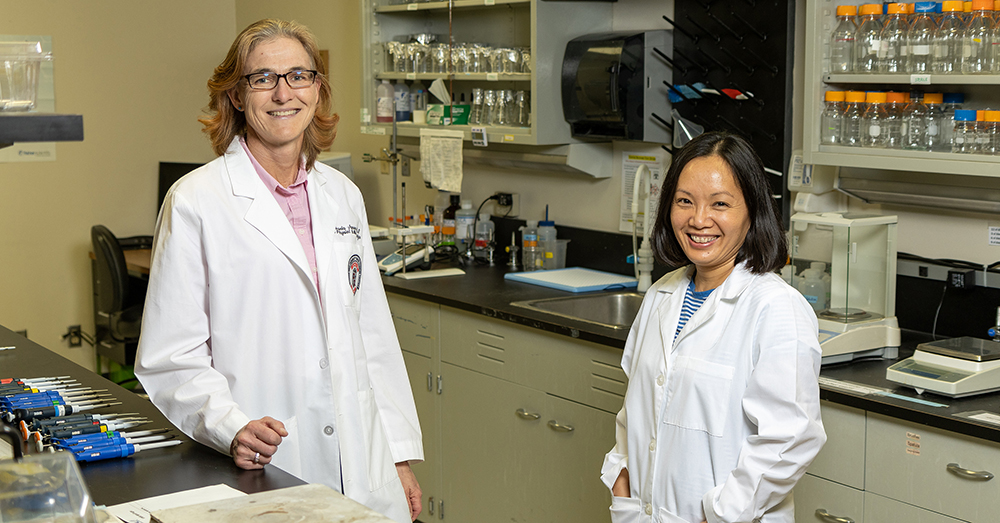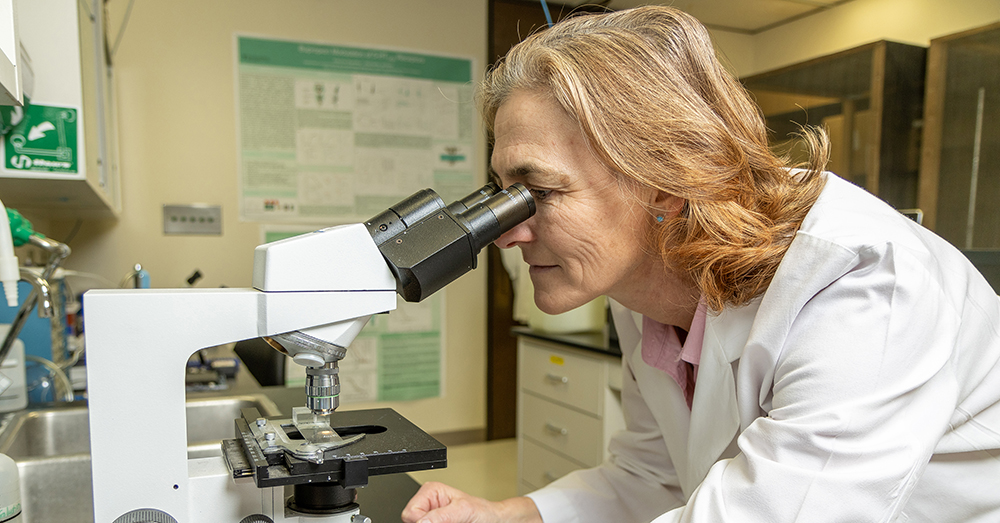TTUHSC’s Jansen Receives NIH Grant to Continue Study into Neurological Disorders
Research Focuses on Intracellular Domain of Protein Superfamily

According to the Global Burden of Disease study, neurological disorders are the leading cause of disability and the second leading cause of death after heart disease. Malfunctions in pentameric ligand-gated ion channels (pLGICs) have been linked to many of these conditions including Alzheimer’s and Parkinson’s diseases, epilepsy, anxiety disorders, pain, schizophrenia, atherosclerosis, diabetes, inflammatory bowel disease, sepsis and myasthenia gravis, a chronic autoimmune disease that causes certain muscles to weaken.
Primarily located within the central and peripheral nervous systems, pLGICs bind with neurotransmitters and hence produce an electrical signal by managing ion channel activity. Members of the pLGIC superfamily of proteins are assembled from five subunits, each consisting of three domains: the extracellular domain (ECD), the transmembrane domain (TMD) and the intracellular domain (ICD).
In previous research, Michaela Jansen, Pharm.D., Ph.D., an associate professor in the Department of Cell Physiology and Molecular Biophysics at the Texas Tech University Health Sciences Center (TTUHSC) School of Medicine, showed that the ICD of Serotonin type 3A (5-HT3A) receptors interacts with a chaperone protein known as Resistance to Inhibitors of Cholinesterase 3 (RIC-3). Chaperone proteins like RIC-3 help pLGIC protein subunits such as 5-HT3A assemble and function properly.

Jansen’s laboratory is part of TTUHSC’s prominent excellence cluster, the Center for Membrane Protein Research. The center includes approximately 20 principal investigators and their respective laboratories at the TTUHSC School of Medicine and Texas Tech University.
To continue her research, the National Institute of Neurological Disorders and Stroke (NINDS) at the National Institutes for Health (NIH) recently awarded Jansen a four-year, $1.53 million grant. The goal of the grant is to fill in important knowledge gaps pertaining to interactions of pLGICs with RIC-3-like chaperone proteins and conformational changes that occur during gating.
Jansen’s research has focused on neurotransmitter-gated ion channels initially related to new chemical entity or drug development and, since the early 2000s, to the studies of how these chemicals interact with their receptors. She has been funded by NINDS since 2007. With this latest renewal, NINDS will have funded Jansen’s current project for $3.56 million from 2015-2025. Her TTUHSC research team for this project includes present and recent past members Quynh Hoa Do, Ph.D., Akash Pandhare, M.D., Ph.D., Antonia Stuebler, Ph.D., and Elham Pirayesh, Ph.D.
Because pGLIC ICDs hold promise as subunit-specific targets for neuropsychiatric, neurodegenerative and inflammatory diseases, Jansen’s proposed project will test the novel hypothesis that the ICD of certain cation-conducting pLGICs is intricately involved in the critical mechanisms of assembly, chaperone-modulation and functional conformational transitions.

“We will conduct extensive studies now to also include related subunits; not only the 5-HT3A, but also the alpha-7 subunits and other neural nicotonic acetylcholine receptor subunits,” Jansen said.
The idea is to see if these subunits also have some interaction mediated via a peptide chain similar to the one shown to affect the interaction between 5-HT3A and RIC-3 in Jansen’s previous research. Known also as the α7 receptor, the alpha-7 nicotinic receptor is a type of nicotinic acetylcholine receptor implicated in long-term memory.
“If we know exactly which part [of the peptide chain] is important, we are now at the point where we could design peptidomimetics, which are drugs that mimic peptides, and they could interfere with this RIC-3-5HT3A interaction,” Jansen explained. “This could be helpful to, for example, correct how many receptors are on the plasma membrane, or it could stabilize receptors.”
pLGICs have been established as targets for anesthetics, muscle relaxants, antiemetics, anxiolytics, antiepileptics, drugs that treat dementias and some that support smoking cessation. Jansen said undesired clinical effects based on interactions with off-target, structurally-related subunits often limit or prevent their clinical use.
With this competitive renewal of her NIH R01 grant, Jansen said her team will test their hypotheses to gain additional detailed and mechanistic insights into the ICD, which Jansen said has received significantly less attention compared to the two other domains.
“We are now just looking at more neurotransmitter receptors, and also looking more at some detailed mechanisms,” Jansen said. How does this protein segment move is one question; the second question is, is it similar to other neurotransmitter receptors? And the third question would be, can we make drugs that interfere with this peptide?”
Related Stories
Celebrating Veterans: TTUHSC’s General Martin Clay’s Legacy of Service and Leadership
From his initial enlistment in the Army National Guard 36 years ago to his leadership in military and civilian health care management roles, Major General Martin Clay’s career has been shaped by adaptability, mission focus and service to others.
Texas Tech University Health Sciences Center School of Nursing Named Best Accelerated Bachelor of Science in Nursing Program in Texas
The TTUHSC School of Nursing Accelerated Bachelor of Science in Nursing (BSN) program has been ranked the No. 1 accelerated nursing program in Texas by RegisteredNursing.org.
TTUHSC Names New Regional Dean for the School of Nursing
Louise Rice, DNP, RN, has been named regional dean of the TTUHSC School of Nursing on the Amarillo campus.
Recent Stories
Making Mental Health a Priority in the New Year
Sarah Mallard Wakefield, M.D., a psychiatrist with Texas Tech Physicians, talks about strategies to combat widespread and growing anxiety.
TTUHSC Cancer Researcher Honored by National Academy of Inventors
C. Patrick Reynolds, M.D., Ph.D., director of the School of Medicine Pediatric Cancer Research Center at TTUHSC, has dedicated his life as a researcher to developing treatments for childhood cancers.
TTUHSC School of Nursing Celebrates 10 Years of the Veteran to BSN Program
The TTUHSC School of Nursing recognized the 10-year anniversary of the Veteran to Bachelor of Science in Nursing (VBSN) program during the fall 2025 commencement ceremonies held Dec. 13 in Lubbock, Texas.
